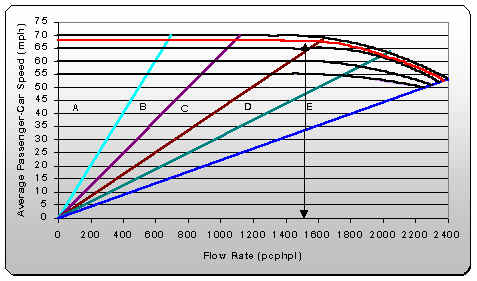
Determining LOS and Density
An existing freeway has the following characteristics:
- 8 lanes
- Carries a flow of 4000 vph
- Trucks make up 8% and RVs 2% of the flow
- 12-foot lane widths
- Interchange density is less than 0.5 per mile
- Obstructions within 4 feet of the outside edges of the freeway
- PHF is 0.95
We are interested in determining the existing LOS and density as well as the maximum
service flow rate at capacity (LOS E) for a two-mile section of this freeway with a grade
of +4%
[Solution Shown Below]
Solution
In order to determine the existing LOS using the applicable graph or table, we need to
calculate (1) the service flow rate and (2) the adjusted free-flow speed.
1. The service (or passenger-car equivalent) flow rate calculation is as follows:

V = hourly peak hour volume (vph) = 4,000
PHF = peak-hour factor = 0.95
fHV = heavy-vehicle adjustment factor =
 
fp = driver population factor = 1.0 (assumed)
vp = 15-minute passenger-car equivalent flow rate (pcphpl)

2. The free-flow speed calculation is as follows:
FFS = 70 – fLW – fLC – fN - fID
Where
fLW = adjustment for lane width = 0
fLC = adjustment for right-shoulder lateral clearance = 0.4
fN = adjustment for number of lanes = 1.5
fID = adjustment for interchange density = 0
FSS = estimated free-flow speed = 70 – 0 – 0.4 – 1.5 – 0 = 68.1
mph
We then draw the free-flow speed curve of 68.1 mph on the graph as shown below.

At the flow rate of 1526 pcphpl, the LOS is C. Density is calculated as:
D = vp/S
Where
vp = flow rate (pcphpl) = 1,526, and
S = average passenger-car speed (mph) = 67 (from the graph) and
D = density (pc/mi/ln) = 23.7 pc/mi/ln.
The flow at capacity can be taken from the graph above, at the end of the red line as
2380 pcphpl.
|